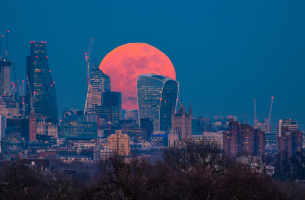• Shoot in manual so you can choose the optimum settings. You’re after the fastest shutter speed possible, because the moon is actually moving quite fast across the sky, so you need to be able to freeze its motion. If you’re shooting handheld, consider 1/1000sec to 1/1500sec, while if you’re using a tripod, which is advisable to help reduce blur and also help you with your framing, consider 1/125sec to 1/250sec. Go for a low ISO – start at 100 and increase as necessary. Shooting in RAW (NEF) will give you more options for correcting and improving the image on the computer later.
• Set your camera for increased sharpness and contrast. Get the photo as sharp as you can straight out of the camera, and if you then decide you don’t like it, you can always unsharpen it later. Increasing the contrast will give you a much punchier result, which is important in a mainly monotone image. You can boost this further by using the red filter in the monochrome setting, as this will give you more of a punch between the blacks and the whites, and a greater distinction between the craters of the moon and what little shadows there are.
• A large telephoto lens like a 500mm is ideal for rendering detail and delivering sharp focus and dramatic size, but it’s also possible to get satisfying results with a 70-300mm or a 200-400mm NIKKOR. If you’re using a lens shorter than 500mm, set it to infinity and close down to f/11 or f/16 to let depth of field help with focus. Try a selection of images, from a huge shot just of the moon to capture all of its graphic round detail, to shots of it lower down on the horizon framed or fronted by the silhouettes of tree branches, church steeples, people or other foreground features to add a sense of scale.
• For a “normal” full moon, experiment with shooting in black and white as well as colour. The moon is a very grey object, so when the image is properly exposed, there’s negligible difference between a black-and-white photo of it and a colour one. Any yellow cast is actually the reflected light of the sun, so by setting your camera to monochrome you’re retaining the moon’s authentic appearance.
• If you want colour, a rising moon is a great opportunity to capture it, as the sunset sky can create a dramatic pink or red colour cast. During a total lunar eclipse, the moon will go from an initial, normal grey to orange, amber and fiery red at totality – giving you the opportunity to record a series of shots showing the colour changes and the moon’s procession across the night sky, which you can then blend together in post-production.

